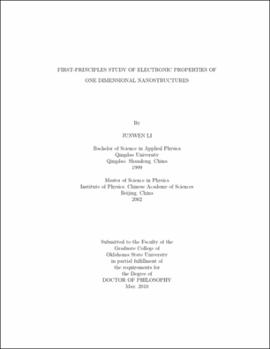| dc.contributor.advisor | Mintmire, John W. | |
| dc.contributor.author | Li, Junwen | |
| dc.date.accessioned | 2013-11-26T08:26:34Z | |
| dc.date.available | 2013-11-26T08:26:34Z | |
| dc.date.issued | 2010-05 | |
| dc.identifier.uri | https://hdl.handle.net/11244/6903 | |
| dc.description.abstract | Scope and Method of Study: | |
| dc.description.abstract | In this work, we present simulation results for the electronic properties of two types of quasi-one-dimensional nanostructures: graphene nanoribbons and silicon nanowires. The electronic structures throughout the dissertation were calculated within a first-principles, all-electron, self-consistent local density functional (LDF) approach tailored for helical symmetry. Tight-binding models (TBM) were employed to study the energy gaps and bonding characteristics of armchair graphene nanoribbons. Within the study of silicon nanowires, we were interested in surface passivation effects and electronic transport properties of silicon nanowires with surface effects. The transport calculation makes use of the Landauer approach implemented with non-equilibrium Green's function formalism. | |
| dc.description.abstract | Findings and Conclusions: | |
| dc.description.abstract | For the study of graphene nanoribbons, we found that the zigzag ribbons exhibited spin-polarized ground states with ferromagnetic edges on opposite sides aligned antiferromagnetically. The electron states near the Fermi level in zigzag ribbons are localized on the edge carbon atoms. The armchair ribbons have ground states of degenerate spin configuration and the LDF energy gaps separate into three families, which is not consistent with the nearest-neighbor TBM. The third-nearest-neighbor interaction was introduced to resolve the discrepancy between LDF and TBM in armchair ribbons. We found that armchair graphene ribbons have two different responses to twist deformation according to ribbon widths, suggesting potential nanomechanical application. In the investigation of silicon nanowires, we found that passivation using hydroxyl or methyl groups reduced the band gaps compared to hydrogen-terminated Si nanowires, and passivation using methyl groups produced systems with indirect gaps for all <100> Si nanowires studied. All band gaps were direct in the <110> Si nanowires independent of passivation. The distributions of near-gap orbitals were greatly affected by the surface substituents. We also found that the carrier effective masses of <100> Si nanowires were sensitive to the diameter and passivation, while those of <110> Si nanowires were not. We show that the hydroxyl defects can greatly reduce the conductance of hydrogen-passivated Si nanowires and can be used to tune the conductance of the silicon nanowires. | |
| dc.format | application/pdf | |
| dc.language | en_US | |
| dc.publisher | | |
| dc.rights | Copyright is held by the author who has granted the Oklahoma State University Library the non-exclusive right to share this material in its institutional repository. Contact Digital Library Services at lib-dls@okstate.edu or 405-744-9161 for the permission policy on the use, reproduction or distribution of this material. | |
| dc.title | First-principles study of electronic properties of one dimensional nanostructures | |
| dc.contributor.committeeMember | Wilson, Timothy Michael | |
| dc.contributor.committeeMember | Guo, Yin | |
| dc.contributor.committeeMember | Materer, Nicholas | |
| osu.filename | Li_okstate_0664D_10817.pdf | |
| osu.accesstype | Open Access | |
| dc.type.genre | Dissertation | |
| dc.type.material | Text | |
| dc.subject.keywords | DFT | |
| dc.subject.keywords | electronic structure | |
| dc.subject.keywords | graphene nanoribbon | |
| dc.subject.keywords | helical symmetry | |
| dc.subject.keywords | quantum transport | |
| dc.subject.keywords | silicon nanowire | |
| thesis.degree.discipline | Physics | |
| thesis.degree.grantor | Oklahoma State University | |
